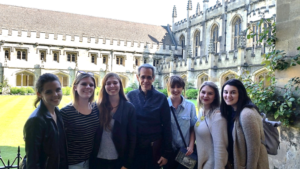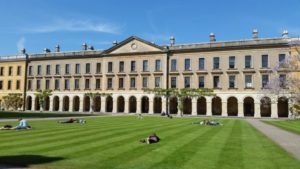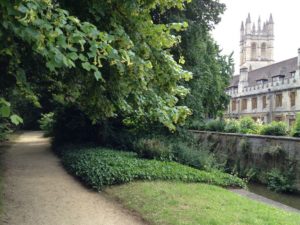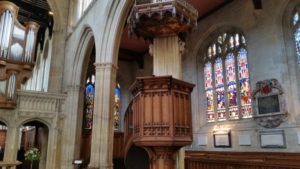Lewis’s Oxford
For something a little different, here is a brief glimpse of the real world university where C. S. Lewis lived and worked as a professor for much of his life:
Lewis’s Oxford
by Professor Alan Synder
Twenty years ago, I had a whirlwind tour of a very small section of Oxford. This time, with my university students, I was able to spend a little more time—not enough, but more directed, more significant, more focused on the sites with which C. S. Lewis was familiar.
Lewis taught at Magdalen College for approximately thirty years. For the first time in my sixty-six years, I was on the same grounds.

Lewis’s rooms were in the New Building (“new” because it wasn’t built until the eighteenth century), top floor, the two windows to the right of the protruding section in the middle.

I neglected to take a picture of the sign that told students to keep off the grass. It would have been humorous.
Next to the New Building was the entrance to Addison’s Walk, a lovely wooded path by the winding river. It was here that Lewis had a long conversation with Tolkien and another Inkling, Hugo Dyson, that convinced him to believe in God.

We also stopped by the University Church of St. Mary the Virgin. It was from this pulpit that Lewis delivered one of the most powerful sermons I’ve ever read: “The Weight of Glory.”

My favorite passage from that sermon is a poignant reminder of how we should view other people:
It is a serious thing to live in a society of possible gods and goddesses, to remember that the dullest and most uninteresting person you talk to may one day be a creature which, if you saw it now, you would be strongly tempted to worship, or else a horror and a corruption such as you now meet, if at all, only in a nightmare. All day long we are, in some degree, helping each other to one or other of these destinations. . . .
There are no ordinary people. You have never talked to a mere mortal. Nations, cultures, arts, civilization—these are mortal, and their life is to ours as the life of a gnat. But it is immortals whom we joke with, work with, marry, snub, and exploit—immortal horrors or everlasting splendours.
*
This is the end of the portion about Lewis’s school, but continue to Professor Snyder’s blog to see photos from his trip to The Eagle and The Child, the pub where the Inkings–Tolkien, Lewis, and their friends–would meet to discuss philosophy and literature.

Leave a comment